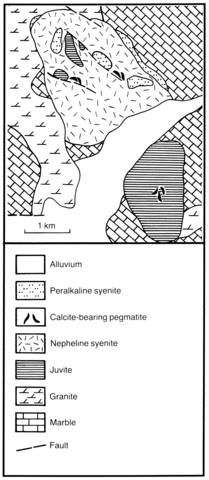stripes
The alkaline rocks of the Bayankol complex cut Upper Proterozoic marbles and Lower Palaeozoic granitoids. The complex is oval in outline but a deep valley divides it into two separate outcrop areas. The northern area covers about 5 km2 and has a complicated structure, the greater part being a complex of layered nepheline syenites. The layering comprises both alternating bands enriched or impoverished in mafic minerals and alternating layers with different mineral compositions; in both melanocratic and mesocratic layers there is a distinct trachytic texture. Two types of layering have been identified. In the lower part of the stratified complex an "incompletely differentiated" series is developed which is represented by alternating melanocratic, mesocratic and leucocratic nepheline syenites. An increase of nepheline occurs in the upper part of leucocratic layers. The second type of stratified series is "completely differentiated" and is common in the central and upper parts of the stratified complex. Within nepheline syenites layers of juvite and urtite from 10-50 cm thick are present. The rocks richer in nepheline occur in the upper part of the leucocratic rocks near the boundary separating them from the overlying melanocratic nepheline syenites, which are occasionally malignites. In places nepheline-magnetite rocks occur instead of urtite. The nepheline syenites include nepheline (16-39%), microcline-perthite (49-59%), Na-hedenbergite (1-22%), lepidomelane (4-11%) and lesser amounts of sodalite, cancrinite, albite, titanomagnetite and apatite. In juvites the nepheline content increases with a commensurate decrease of the microcline-perthite (25-38%) and Na-hedenbergite. The northern part of the complex is rich in pegmatitic syenites mineralogically similar to the juvites. Nepheline syenitic pegmatites up to 15x4 m are encountered; they are located within an area 300 m long. The southern part of the complex covers 3 km2. It has a more homogeneous composition being composed essentially of urtite/juvite which consists predominantly of nepheline (80-90%). Post-magmatic albitization and calcitization has taken place. Calcite lenses and vein-like bodies 0.2-1 m thick occur. Apart from calcite, microcline-perthite, biotite, apatite and titanite are also present. Calcite from veins and lenses and from juvite gave Ù18Oo/oo SMOW values from 13.8 to 15.3 and Ù13Co/oo PDB from -2.7 to -4.6. There appears to have been a mixed source for the calcite.
KONONOVA, V.A. 1962. The primary layered Ba'ankol intrusion of hedenbergite nepheline syenite. In O.A. Vorob'eva (ed) Alkaline rocks of Siberia. 39-70. USSR Academy of Sciences, Moscow.
KONONOVA, V.A. 1976. The Jacupirangite-urtite series of alkaline rocks. Nauka, Moscow. 214pp.
*KONONOVA, V.A. and YASHINA, R.M. 1984. Geochemical criteria for differentiating between rare-metallic carbonatites and barren carbonatite-like rocks. Indian Mineralogist (Sukheswala Volume), 136-50.
YASHINA, R.M. and BORISEVICH, I.V. 1966. The age of the alkaline rocks of East Tuva. InG.D. Afanas'ev (ed) Dating of the tectono-magmatic cycles and metallogenic stages. 326-36. Nauka, Moscow.
ZYKOV, S.I., STUPNIKOVA, N.I., PAVLENKO, A.S., TUGARINOV, A.I. and ORLOVA M.P. 1961. The age of the intrusions from East Tuva and the Enisei Range. Geokhimiya. Akademiya Nauk SSSR, Moskva, 7: 547-60.

